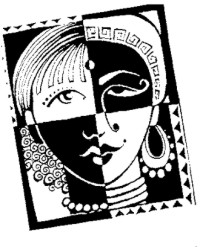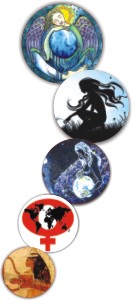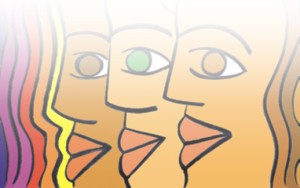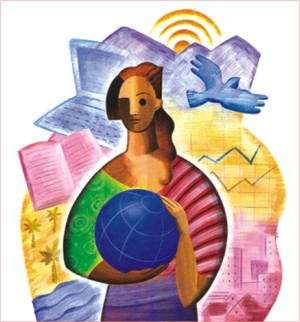| Spotlight
International Women's Day 2009
United Fight Against Violence
Tanzina Rahman
 Locked in her eyes was a glimpse of ache. The girl looked at me with teary eyes, her mouth covered with her torn shawl and her hands shaking as she tried to calm down and sit beside me. I gave her a reassured look, but deep inside even I knew nothing could beat the lamentable memories that were daunting the girl's tone as she tried to speak with me. Locked in her eyes was a glimpse of ache. The girl looked at me with teary eyes, her mouth covered with her torn shawl and her hands shaking as she tried to calm down and sit beside me. I gave her a reassured look, but deep inside even I knew nothing could beat the lamentable memories that were daunting the girl's tone as she tried to speak with me.
“I really tried to escape from that house, but the guards at the main gate took me forcefully inside the house and the house owner hit me and threw boiling water at me in spite of my blaring shouts…”, Ayisha (not her real name) continued.
Eleven year old Ayisha was brought from her village home in Sherpur to serve as a house maid and was required to do almost every chore in the house and if by any chance a heavy bucket of water or a plate fell, she would be beaten without respite.
There is nothing unique about this story. Like any other case of domestic violence in Bangladesh, brutal attacks on this poor girl were hidden behind the dark shades.
 According to a United Nations (UN) report, from 2001 to 2007 there have been 53 percent of domestic violence cases in South Asian countries, while it is stated that most of the cases were unreported. Focusing on Bangladesh itself, last year a total of 454 women and girls were reported as victims of rape. Among them 202 were women and 252 young girls. Of them, 68 women and 30 girls were killed after being raped and one woman committed suicide. Numbers continue to increase over the years of such cases, but little changes are apparent in today's society. According to a United Nations (UN) report, from 2001 to 2007 there have been 53 percent of domestic violence cases in South Asian countries, while it is stated that most of the cases were unreported. Focusing on Bangladesh itself, last year a total of 454 women and girls were reported as victims of rape. Among them 202 were women and 252 young girls. Of them, 68 women and 30 girls were killed after being raped and one woman committed suicide. Numbers continue to increase over the years of such cases, but little changes are apparent in today's society.
Which is why, UN, along with several other organizations, governments and women's groups around the world, have chosen a significant theme for this year's International Women's Day (IWD) that will reflect the underlining conception of this ongoing global issue. This year's theme is “Women and Men United to End Violence against Women and Girls”.
IWD, a day that symbolizes the notion of economic, political and social achievements for women's rights, was marked during 20th century when the industrialized world was experiencing great turbulence and crisis. At that time, IWD was aimed to promote women's rights and in 1909 the Socialist Party of America held the first National Women's Day. A year after, in the second International Conference of Working Women, Clara Zetkin (Leader of the 'Women's Office” for the Social Democratic Party in Germany) proposed the idea of IWD as an event to be held on the same day every year around the world where women would press their demands and concerns. Later, several countries including Austria, Denmark, Germany, and Switzerland followed this day to signify women's solidarity.
Today, IWD has taken a global dimension as the day is celebrated all around the world, in some countries it is a national holiday, where women rallies run across streets in support for women's rights. But how far has it been able to accomplish its mission? Yes, women are taking part in presidential and parliamentary elections to vote for the right candidate and they have managed to work in esteemed organizations, nevertheless cases of domestic violence, rape, and sexual assaults are on the rise.
 The existence of organizations and helping hands to protect women have relatively increased over the years, such as Action against Trafficking and Sexual Exploitation of Children (ATSEC), a non-profit organization and a coalition of 15 NGOs working in Bangladesh for prevention of trafficking in children and women and their sexual exploitation or Naripokkho, one of the leading women activist groups to stop violence against women. Yet, abuse against women still continues in the society. The existence of organizations and helping hands to protect women have relatively increased over the years, such as Action against Trafficking and Sexual Exploitation of Children (ATSEC), a non-profit organization and a coalition of 15 NGOs working in Bangladesh for prevention of trafficking in children and women and their sexual exploitation or Naripokkho, one of the leading women activist groups to stop violence against women. Yet, abuse against women still continues in the society.
Almost every now and then national dailies and local dailies reveal rape incidents, and reports state that over the past few years the numbers have relatively remained the same. For instance last month, there were several cases of gruesome attacks on innocent girls. Five year old Sheuly's murder was one of them. Sheuly was strangled to death after she was raped by a neighbouring youth.
Point that needs to be noted is that, 64 percent of women and girls are victimized by a current or former husband, cohabiting partner, boyfriends or a familiar person (findings from National Violence Against Women Survey). This clearly defines that the message is not disseminating properly, or the right people are not taking actions even though the message has reached them.
So we ask ourselves- Is fighting against violence concerning women and girls is a single gender issue? Or is it an issue that disquiets every individual?
Men are more politically involved and are denoted to be the dominant sex in the society. In many families they are the single source of income as well as the decision makers. On the contrary, because of men, women are still struggling for equality, peace, justice and development. Therefore, men's involvement in women's rights issues will not only add on to the overall agenda to overcome problems in the society, but will also act as a catalyst to solve them.
About half of the population in Bangladesh is women, the majority of whom are underprivileged, under-nourished, illiterate and poor. If the other half of Bangladesh's population- the men, stands up to proclaim women's rights and assists them to build a safer environment, then empowerment of women would increase vastly in the coming years.
 
8th March is marked as the International Women's Day. In regard to this very significant day Star Campus collected views from various people, some of whom who are working with young women everyday while others represent their empowerment in the social sectors. We asked them about the significance of International Woman's Day and what womanhood means to them. Stressing on this year's theme, which is "Men And Women United To End Violence Against Women And Girls", we also asked how this year's theme contributes to our society.
Interviewed by Tanzina Rahman
Janannatul Mawa
Assistant News Producer in abc Radio
Why do we celebrate womanhood once a year? International Women's Day has been given such preference and importance that I think people often forget that womanhood is not only a “one day” thing. I think all 365 days should be equally considered to stand for woman's rights and to help build a world that will inspire women every day.
Mahfuza Rahman
Housewife
In the past, photographs of women would appear in the packaging of products or in advertisements; it was a technique that was used to grasp consumers' attention. But as we look around our society today, the same tricks of portraying women are being practiced. Yes, in terms of empowerment we have managed to reach the bar. But the wrong way of depicting women still continues. I think the society should stop portraying women as products and instead give them the reputable stand that they deserve.
Kuntala Shabnam
MA Applied Linguistics and ELT student, DU (English Department)
I think this year's theme is a wonderful way to tell our society that both men and women should work together to create awareness for women's rights. Together we will be able to make a safer society.
And I can't describe womanhood in one sentence; it has rather a complex meaning that I think no woman can perfectly describe. That is because, we feel deeply about womanhood and its existence in the world.
 Professor Firdous Azim Professor Firdous Azim
Chairperson of Department of English & Humanities, BRAC University
If you want me to describe women in today's society, I believe relatively women's position has improved. Yet, it has not reached the bar. If we look closely, women are working as subordinates in workplaces compared to men. Gender base subordination movement should be highlighted, and only then it will be a social justice. What today's women are talking about is equality.
Even today many families are giving more importance to males rather than females. Women are expected to have more responsibilities towards the family than men. I'm saying that because I'm a teacher, I work with young women all the time. And the majority of them don't have as high ambitions compare to men. Women are abiding by their familial responsibilities. They are sacrificing opportunities either because their families are supporting them or they themselves cannot put up with the society. So when a brilliant student comes up to me with a disappointing face saying even though she got the scholarship she can't go abroad to study, I feel women are not given the freedom that they deserve to have. When it comes to men, their ambitions are far off the leash than that of women. I see men taking those opportunities and becoming the leaders of next generation.
The attitude has to be changed on personal levels.
Shumana Sharmin
Feature Editor of Prothom Alo
Those of us who are working in the Media, we write for both genders and not particularly for women. Which is why, when we highlight women's rights issues, we don't necessarily place it under a particular section, it can be a part of the main paper or it can be a part of the women's weekly section. Point is, we want both men and women to read it.
This year's IWD theme also stresses on the same idea, men and women are being asked to work against violence. Therefore, our target as journalists should be writing for both genders. And I'm glad to say this that every year, both men and women work on women's rights related projects in Prothom Alo, which motivates our male readers to read more.
Anisul Hoque
Deputy Editor of Prothom Alo
Bicycles have two tires; both have to work together in order to ride the cycle. That is why I feel that both men and women have to work together and have to help each other to make a better society. Every single individual should change himself or herself. We are educated, but whether the education is taken into personal level is a matter of question.

Compiled by Tabassum Mokhduma
International Women's Day has been observed since early 1900's, a time of great expansion and turbulence in the industrialized world that saw booming population growth and the rise of radical ideologies. Every year on 8 March the world celebrates IWD to celebrate womanhood, to ensure women's all kinds of rights as well as to give proper recognition to their achievement and the honour they deserve. But this day did not establish its importance overnight. Like many other revolution, it has its own history which started a long time ago.
In 1869 British MP John Stuart Mill was the first person in Parliament to call for women's right to vote. On 19 September 1893 New Zealand became the first country in the world to give women the right to vote. Women in other countries did not enjoy this equality and campaigned for justice for many years.
In 1908 Great unrest and critical debate was occurring amongst women. Women's oppression and inequality was spurring women to become more vocal and active in campaigning for change. Then in 1908, around 15,000 women marched through New York City demanding shorter hours, better pay and voting rights.
In accordance with a declaration by the Socialist Party of America, In the year 1909 the first National Woman's Day (NWD) was observed across the United States on 28 February. Women continued to celebrate NWD on the last Sunday of February until 1913.
In 1910 a second International Conference of Working Women was held in Copenhagen. A woman named Clara Zetkin (Leader of the 'Women's Office' for the Social Democratic Party in Germany) tabled the idea of an IWD. She proposed that every year in every country there should be a celebration on the same day - a Women's Day - to press for their demands. The conference of over 100 women from 17 countries, representing unions, socialist parties, working women's clubs, and including the first three women elected to the Finnish parliament, greeted Zetkin's suggestion with unanimous approval and thus International Women's Day was the result.
The very first IWD was launched the following year by Clara Zetkin on 19 March (not 8 March). The date was chosen because on 19 March in the year of the 1848 revolution, the Prussian king recognized for the first time the strength of the armed people and gave way before the threat of a proletarian uprising. Among the many promise he made, which he later failed to keep, was the introduction of votes for women.
Plans for the first IWD demonstration were spread by word of mouth and in the press. During the week before International Women's Day two journals appeared: The Vote for Women in Germany and Women's Day in Austria. Various articles were devoted to International Women's Day: 'Women and Parliament', 'The Working Women and Municipal Affairs', 'What Has The Housewife Got To Do With Politics?', etc. The articles thoroughly analyzed the question of the equality of women in the government and in society. All articles emphasized the same point that it was absolutely necessary to make parliament more democratic by extending the franchise to women.
The first International Women's Day in 1911 was honoured the first time in Austria, Denmark, Germany and Switzerland on 19 March and its success exceeded all expectation. More than one million women and men attended IWD rallies campaigning for women's rights to work, vote, be trained, to hold public office and end discrimination. Meetings were organized everywhere in small towns and even the villages halls were packed so full that male workers were asked to give up their places for women. Men stayed at home with their children for a change, and their wives, the captive housewives, went to meetings.
In 1913 International Women's Day was transferred to 8 March and this day has remained the global date for International Women's Day ever since.
For decades, IWD has grown from strength to strength annually. For many years the United Nations has held an annual IWD conference to coordinate international efforts for women's rights and participation in social, political and economic processes. 1975 was designated as 'International Women's Year' by the United Nations. The United States even designates the whole month of March as 'Women's History Month'.
IWD is now an official holiday in China, Armenia, Russia, Azerbaijan, Belarus, Bulgaria, Kazakhstan, Kyrgyzstan, Macedonia, Moldova, Mongolia, Tajikistan, Ukraine, Uzbekistan and Vietnam. The tradition sees men honouring their mothers, wives, girlfriends, colleagues, etc with flowers and small gifts. In some countries IWD has the equivalent status of Mother's Day where children give small presents to their mothers and grandmothers.
source:
http://www.internationalwomensday.com/about.asp
http://www.internationalwomensday.com/first.asp
 Did you know that… Did you know that…
Compiled by Tabassum Mokhduma
Women use 20,000 words a day while men only use 7,000
· Females in developing countries on average carry 20 litres of water per day over 6 km
· Globally women account for the majority of people aged over 60 and over 80
 · Pregnant women in Africa are 180 times more likely to die than in Western Europe · Pregnant women in Africa are 180 times more likely to die than in Western Europe
· 530,000 women die in pregnancy or childbirth each year
· World population hit 6,872,741,131 on 1 January 2009
· Of 1.2 billion people living in poverty worldwide, 70% are women
· 80% of the world's 27 million refugees are women
· Women own around only 1% of the world's land
· AIDS sees women's life expectancy of 43 in Uganda and Zambia
· 5 people are added to the world's population every 2 seconds
· Women are 2/3 of the 1 billion+ illiterate adults who have no access to basic education
· Globally women comprise 42% internet users (Italy 37% ... US & Canada 51%)
· In OECD countries women comrpise only 30 per cent of degrees in science and technology
· Women's representation in computer and information sciences workforce is around 30% globally
· Female inventors still only account for around 10% of the US inventor population
· Women control $14 trillion in assets and this should grow to $22 trillion over next 10 years
· Women comprise 21 of the 37 million people living below the poverty line in the US
· Only in Japan and Peru are women more active in starting a business than men
· Women spend more time researching before they invest than men do
· Only 21% of all news subjects (people interviewed or whom the news is about) are female
· Women less than 1% department heads, editors, media owners but third of working journalists
· 80% of UK purchasing decisions are made by women but 83% of 'creatives' are men
· Women do two-thirds of the world's work but receive only 10% of the world's income
· Women's education is the most powerful predictor of lower fertility rates
· One year out of college women earn 20% less than men and 10 years later 31% less
· Women on average are away from workforce for 14.7 years compared to 1.6 years for men
· The biggest EU gender pay gap is in Cyprus and Estonia at 25% then Slovakia at 24%
· 56% of women who voted supported Obama compared to only 49% of men voted for Obama
· Until 20 years ago there had never been more than 5% women MPs globally
· Benazir Bhutto was the first woman prime minister of a muslim country (assassinated 27/12/07)
· From the 27 EU member states, UK ranks 15 for women's representation in national Parliaments
· From 1945 to 1995 the percentage of women MPs worldwide increased four-fold
Source: http://www.internationalwomensday.com/facts.asp |

